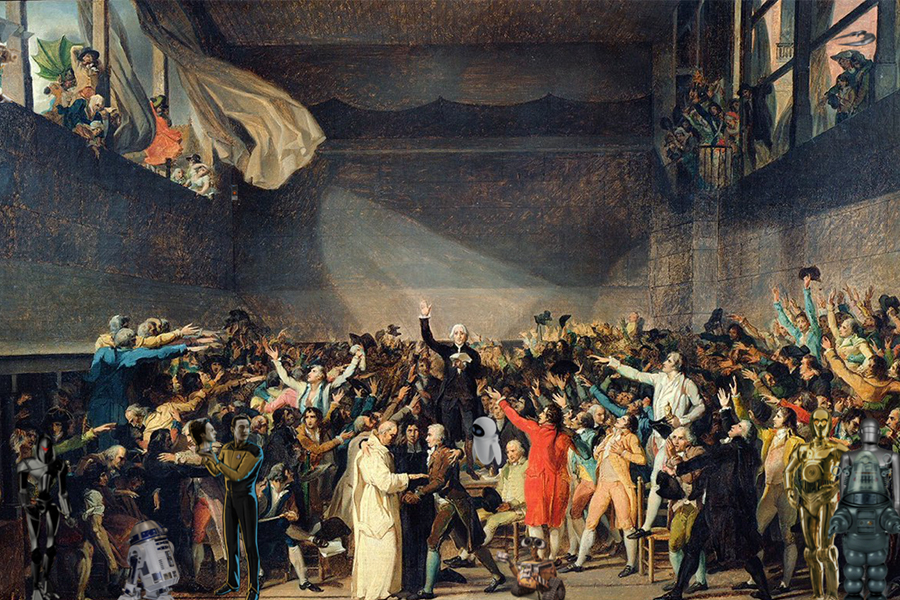
Machine Learning Yields New Insights Into French Revolution’s Early Days
By Shilo Rea
The French Revolution was one of the most important political transformations in history. Even more than 200 years later, it is held up as a model of democratic nation building. For years, historians and political scientists have wondered just how the democratic trailblazers of the French Revolution managed to pull off the creation of an entirely new kind of governance.
New research published in the Proceedings of the National Academy of Sciences and from a collaboration of historians, political scientists and statisticians suggests that rhetorical innovations may have played a significant role in winning acceptance for the new principles of governance that built the French republic’s foundation — and inspired future democracies around the world.
The research team, which includes Carnegie Mellon University’s Simon DeDeo, used machine learning techniques to comb through transcripts of nearly 40,000 speeches from the deliberations of the makeshift assembly formed during the revolution’s early days to hash out the laws and institutions of the new government.
The researchers analyzed speech patterns to determine how novel they were and whether they persisted or disappeared over time. They also categorized speech patterns by political affiliation and context — whether the speech was given during the assembly’s public deliberations or in a committee held behind closed doors.
They found that in general, assembly members who broke from convention and made their case in new ways were more effective in getting their proposals adopted. For example, revolutionary leader Maximilien Robespierre used new turns of phrase to communicate new ideas that then became new principles of the nascent government.
But not every new idea was well accepted. More conservative members of the assembly, who tended to use more traditional language, may not have been as influential as their more inventive counterparts on the left, but they often played an important role in keeping debates focused and infusing them with a dose of practicality.
“You see crucial players on the left wing who are sources of new ideas and new patterns of speaking,” said DeDeo, assistant professor of social and decision sciences in CMU’s Dietrich College of Humanities and Social Sciences who also holds at appointment at the Santa Fe Institute. “When they introduce these patterns they stick around. These are people who are bringing new ideas to the table, ideas that persist downstream.”
On how conservatives played a different role, DeDeo said, “They tend not to introduce new things — they’re following the course of the discussion, keeping the conversation on track. So you can see Robespierre introduce something — human rights, say — and the right doesn’t dismiss it, it discusses: ‘Let’s pause here and take that up.’”
Rebecca Spang, professor of history at Indiana University, noted how “a lot of the novelty doesn’t stick.”
“There are a lot of new turns of phrase that people were offering in the political lobby and the audience didn’t go for it. On the other hand, there were other things that did stick. And that’s what we call the revolution,” Spang said.
An unexpected insight from the analysis was that some of the most important work of the revolution was done in the committees, which were formed to work out particularly difficult issues and then present a recommendation to the full assembly. The small group dynamic allowed assembly members who may not have been powerful orators to exert influence.
“One thing we didn’t realize until doing this study was how many lesser-known revolutionaries were also working assiduously in the assembly, doing it through the assembly’s committees,” said Spang.
DeDeo believes the analysis shows how important individual members of a government body can be in shaping policy and that the lessons apply to today’s lawmakers as well.
“Some of the lessons we get out of it is that individuals do matter,” he said. “So you might say, who’s the Robespierre of Congress in 2018? And who’s keeping the conversation on track? Today, you might find that it’s the right wing introducing new things, with the left acting as a brake on what the right wants to do.”
The group will release the software it developed for the project so that other researchers can use it to conduct analyses of other government bodies around the world.
In addition to DeDeo and Spang, Indiana University’s Alexander T. J. Barron and Jenny Huang participated in the research.
Pictured above: An adaptation of "Drawing of the Tennis Court Oath," by Jacques-Louis David, that incorporates 11 robots. Credit: Association of Cybernetic Historians